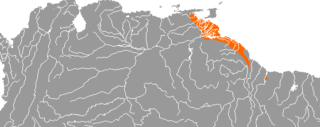Warao language
| Warao | |
|---|---|
| Native to | Venezuela, Guyana, Suriname |
| Ethnicity | Warao |
Native speakers | 32,800 (2005–2011)[1] |
| Language codes | |
| ISO 639-3 | wba |
| Glottolog | wara1303 |
| ELP | Warao |
 | |
Warao (also known as Guarauno, Guarao, Warrau) is the native language of the
Classification
Warao appears to be a
Waroid hypothesis
Granberry also finds "
Language contact
Jolkesky (2016) notes that there are lexical similarities with the
Demographics
The language had an estimated 28,100 speakers in Venezuela as of 2007. The Warao people live chiefly in the Orinoco Delta region of northeastern Venezuela, with smaller communities in southwestern Trinidad (Trinidad and Tobago), western Guyana and Suriname.[8] The language is considered endangered by UNESCO.[9]
Varieties
Historical sources mention ethnic groups in the Orinoco Delta such as Siawani (Chaguanes), Veriotaus (Farautes), and Tiuitiuas (Tibitíbis) that spoke Warao or languages closely related to modern Warao. Other extinct groups include:[10]: 1243
- Aricari and Pirao from Cayenne
- Guaiqueri from Margarita Island
Loukotka (1968) lists the following varieties:[11]
- Guanoco - spoken on the Laguna de Asfalto, state of Monagas (unattested)
- Chaguan - spoken in the Orinoco Delta on the Manamo branch (unattested)
- Mariusa - spoken in the same region on the Cocuina and Macareo branches
- Waikeri (Guaiqueri)
- Chaguan
- Mariusa
Grammar
The language's basic
Phonology
The Warao consonant inventory is small, but not quite as small as many other South American inventories. It does not contain any notable exotica.
| Labial | Alveolar | Palatal | Velar | Glottal | ||
|---|---|---|---|---|---|---|
| plain | labialized
| |||||
| Plosive | p | t | k | kʷ | ||
| Fricative | s | h | ||||
| Nasal | m | n | ||||
Tap
|
ɺ | |||||
| Approximant | j | w | ||||
The labial plosive /p/ is usually realized as voiced [b]. /ɺ/ has an allophone [d] word-initially and [ɾ] when between /i, a/ and /a/.
There are five oral vowels /a, ɛ, i, ɔ, u/ and five nasal vowels /ã, ẽ, ĩ, õ, ũ/. After /k/, in word-initial position, /u/ becomes [ɨ].[14]
Vocabulary
Loukotka (1968) lists the following basic vocabulary items for Uarao (Warao) and Mariusa.[11]
gloss Uarao Mariusa one isaka xisaka two manámo manamo three dianamu dixamo head akua naxoto eye kamu mu tooth kai i man nibora water ho xo fire hekono xeunu sun yá xokoxi manioc aru aru jaguar tobe tobe house xanóko ubanoko
References
- ^ Warao at Ethnologue (19th ed., 2016)

- ^ "Warao". www.jorojokowarao.de. Retrieved 2013-09-22.
- ^ Vargas, Andrew S. (10 September 2015). "Venezuela's First Film Shot in the Warao Language Is Chosen as Entry for the Oscars". Remezcla. Retrieved 16 July 2021.
- ISBN 9783110255133.
- ^ ISBN 0-19-509427-1. Retrieved 16 July 2021.
- ^ Julian Granberry, A Grammar and Dictionary of the Timucua Language, pp. 15-32
- ^ Jolkesky, Marcelo Pinho de Valhery (2016). Estudo arqueo-ecolinguístico das terras tropicais sul-americanas (Ph.D. dissertation) (2 ed.). Brasília: University of Brasília.
- ^ "WARAO: a language of Venezuela", Ethnologue: Languages of the World, 14th Edition, 2000
- ^ "UNESCO Atlas of the World's Languages in danger". www.unesco.org. Retrieved 2018-03-20.
- ISBN 978-3-11-043273-2.
- ^ a b Loukotka, Čestmír (1968). Classification of South American Indian languages. Los Angeles: UCLA Latin American Center.
- ^ Mason, John Alden (1950). "The languages of South America". In Steward, Julian (ed.). Handbook of South American Indians. Vol. 6. Washington, D.C., Government Printing Office: Smithsonian Institution, Bureau of American Ethnology Bulletin 143. pp. 157–317.
- .
- ^ Osborn Jr., Henry A. (1966). Warao I: Phonology and Morphophonemics. International Journal of American Linguistics.
Other sources
- Osborn Jr, Henry A. (1966b). "Warao II: Nouns, Relationals, and Demonstratives". International Journal of American Linguistics. 32 (3): 253–261. S2CID 144134134.
- Barral, Basilio de. 1979. Diccionario Warao-Castellano, Castellano-Warao. Caracas: UCAB
- Figeroa, Andrés Romero. 1997. A Reference Grammar of Warao. München, Newcastle: Lincom
- Ponce, Peter. 2004. Diccionario Español - Warao. Fundación Turismo de Pedernales.
- Vaquero, Antonio. 1965. Idioma Warao. Morfología, sintaxis, literatura. Estudios Venezolanos Indígenas. Caracas.
- Wilbert, Johannes. 1964. Warao Oral Litrerature. Instituto Caribe de Antropología y Sociología. Fundación La Salle de Ciencias Naturales. Monograph no 9 Caracas: Editorial Sucre.
- Wilbert, Johannes. 1969. Textos Folklóricos de los Indios Warao. Los Angeles: Latin American Center. University of California. Latin American Studies Vol. 12.
